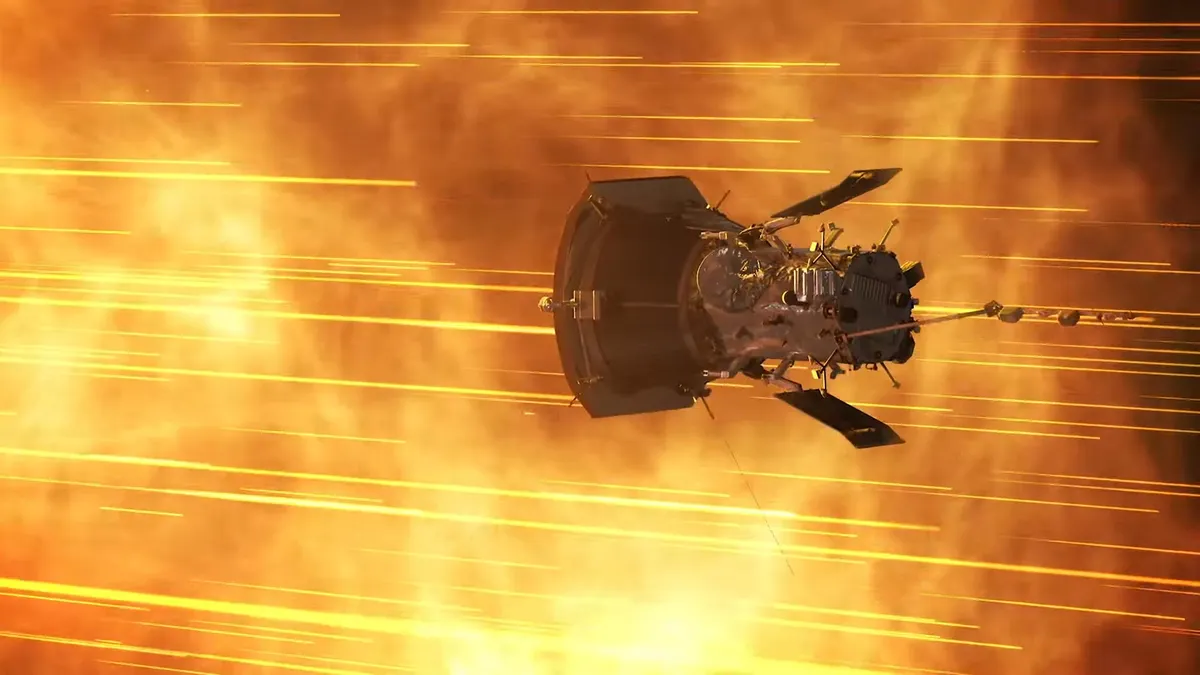
NASA’s Parker Solar Probe is transforming our understanding of the Sun by venturing closer than any spacecraft before. This revolutionary mission has successfully captured breathtaking images from within the solar atmosphere, providing scientists with unprecedented insights into solar dynamics. The Parker Solar Probe has secured the most detailed images ever taken near the Sun, recorded from a mere 3.8 million miles away from its surface.
The new visuals reveal intricate structures within the solar wind, a persistent stream of charged particles emitted by the Sun at staggering speeds exceeding 1 million miles per hour. These groundbreaking images and data are crucial for understanding the formation and behavior of the solar wind, which plays a significant role in influencing Earth’s space environment.
During a historic flyby in late 2024, the Parker Solar Probe captured remarkable new images from deep within the Sun’s atmosphere. These visuals are crucial in helping scientists comprehend how the Sun shapes the broader solar system, particularly the forces that can impact our planet. “Parker Solar Probe has once again transported us into the dynamic atmosphere of our closest star,” stated Nicky Fox, associate administrator of the Science Mission Directorate at NASA Headquarters in Washington. “This new data will immensely improve our space weather predictions, ensuring the safety of our astronauts and protecting our technology both on Earth and in space.”
The Parker Solar Probe began its closest approach to the Sun on December 24, 2024, coming within just 3.8 million miles of the solar surface. During this perihelion, the spacecraft passed through the corona, the Sun’s outer atmosphere. It collected invaluable scientific data using several onboard instruments, including the Wide-Field Imager for Solar Probe (WISPR).
The new WISPR images highlight the corona and solar wind, showcasing a constant flow of electrically charged particles that traverse the solar system, affecting various phenomena. This includes generating auroras, stripping planetary atmospheres, and inducing electric currents that can disrupt power grids and communications on Earth. Understanding the solar wind's impact starts with understanding its origins in the Sun.
The WISPR images provide a close-up look at the solar wind shortly after it is released from the corona. They reveal the crucial boundary where the Sun’s magnetic field direction shifts, known as the heliospheric current sheet, and capture the collision of multiple coronal mass ejections (CMEs) — massive outbursts of charged particles — for the first time in high resolution. “In these images, we’re seeing the CMEs basically piling up on top of one another,” explained Angelos Vourlidas, WISPR instrument scientist at the Johns Hopkins Applied Physics Laboratory, which designed and operates the spacecraft.
When CMEs collide, their trajectories can change, complicating predictions of their paths. Their merger can also accelerate charged particles and mix magnetic fields, potentially increasing the dangers posed to astronauts and satellites in space, as well as technology on Earth. The Parker Solar Probe’s close-up observations enable scientists to better anticipate these space weather effects.
The concept of the solar wind was first theorized by renowned heliophysicist Eugene Parker in 1958. His groundbreaking theories, initially met with skepticism, revolutionized our understanding of the solar system. Before the launch of the Parker Solar Probe in 2018, NASA and its international partners undertook missions like Mariner 2, Helios, Ulysses, Wind, and ACE to study the solar wind from a distance. The Parker Solar Probe, named in honor of Parker, is now filling in the gaps in our understanding of solar phenomena much closer to the Sun.
At Earth, the solar wind appears to be a consistent breeze; however, the Parker Solar Probe uncovered its chaotic nature close to the Sun. When the spacecraft reached within 14.7 million miles of the Sun, it encountered zig-zagging magnetic fields, termed switchbacks. The data from the Parker Solar Probe has revealed that these switchbacks, which occur in clumps, are more prevalent than previously anticipated.
As the Parker Solar Probe ventured closer, it helped scientists identify the origin of these switchbacks at patches on the Sun's surface where magnetic funnels form. In 2024, researchers announced that the fast solar wind — one of the two primary types of solar wind — is partially powered by these switchbacks, solving a long-standing mystery. However, examining the slower solar wind, which travels at only 220 miles per second, remains a challenge.
Understanding how the solar wind is generated and how it escapes the Sun's immense gravitational pull is crucial. The slow solar wind is denser and more variable than the fast solar wind, and it can interact with the fast solar wind to create moderate solar storm conditions that sometimes rival those produced by CMEs. The Parker Solar Probe has confirmed the existence of two types of slow solar wind, providing crucial insights into their unique origins.
In its current orbit, bringing the spacecraft within 3.8 million miles of the Sun, the Parker Solar Probe will continue to gather additional data during its future passes through the corona, with the next significant pass scheduled for September 15, 2025. “We don’t have a final consensus yet, but we have a wealth of new intriguing data,” said Adam Szabo, Parker Solar Probe mission scientist at NASA’s Goddard Space Flight Center in Greenbelt, Maryland.